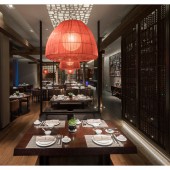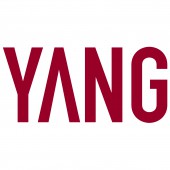Shenzhen Hui Hotel Boutique Hotel by YANG |
Home > Winners > #50681 |
 |
|
||||
| DESIGN DETAILS | |||||
| DESIGN NAME: Shenzhen Hui Hotel PRIMARY FUNCTION: Boutique Hotel INSPIRATION: The design of the hotel focuses on new oriental elements and creates peaceful and natural Chinese aesthetic effect through a mix of Chinese and western furniture as well as the smart decoration of displays and contemporary Chinese artworks. In the lobby, the whole piece of living wall and bird cages in a row make the space simpler. In addition, Hui Hotel seems to be more tranquil with the clear rhythm of birds. UNIQUE PROPERTIES / PROJECT DESCRIPTION: The most representative new Chinese elements such as bird cages, water vats, abacus, etc. can be seen everywhere in the space, expressing the profound Chinese culture essence incisively and vividly. The design of the Cantonese Style Chinese restaurant Yuese, is quite ingenious. By applying lodgepole pines, living walls, water surface, honed stones, wooden furnishing and so forth, the designer brings the mysterious and remote essence of nature into the hotel, making people feel like standing in the middle of a vast forest. OPERATION / FLOW / INTERACTION: - PROJECT DURATION AND LOCATION: The project started in 2010 in Shenzhen and launched in July, 2014 in Shenzhen. FITS BEST INTO CATEGORY: Interior Space and Exhibition Design |
PRODUCTION / REALIZATION TECHNOLOGY: As an old factory transformation project, there can be no big change in the building structures. All the interior design work was limited by the original architectural pattern, which imposes big challenge to the designers. By tearing down the walls on the first floor and placing a 20 meters long desk at the entrance, designers successfully extended the sight and made the lobby a more transparent one. Inspirations were also drew from traditional Lingnan architecture. Designers put wooden structure into use in the entrance ceiling of the Chinese restaurant "Yuese" and built up a sunken indoor courtyard landscape in the deliberately opened-up space between sixth and top floor with a popular book bar introduced, both of which are typical construction methods of Lingnan architecture. In terms of guestroom designing, a 360-rotating all-in-one wardrobe was designed to save space, which also contains the functions of mini bar, full-body mirror, etc. SPECIFICATIONS / TECHNICAL PROPERTIES: The total building area of the Hotel is about 8,800 square meters, including 85 guest rooms, a 400-square-meter ballroom, a Chinese restaurant, an all day dinging restaurant, a heated swimming pool, a gym and so on. Designers maximized the usage of the space, making this tiny piece of land include all the necessities. To ensure the comfortableness of the rooms, each of them takes an area of over 45 square meters. The rooftop is ingeniously transformed into an outdoor bar. As one of China’s intangible heritage, abacus was used as a design element. Through the interpretation of designers, it has become the partition screen in the Chinese restaurant, serving the function of separating the space without literally cutting it off. To create a natural effect of returning to nature, designers applied environmentally friendly straw paint on the Chinese restaurant wall. Designers also replaced walls facing the sun with floor-to-ceiling glasses so as to bring open feelings with natural sunlight and broaden the sight. TAGS: Factory transformation, New Oriental Culture, Lingnan Architecture, Modern Fashion, Natural and Simple Style RESEARCH ABSTRACT: The overall design of the hotel is mainly based on new oriental cultural elements. With the combination of Chinese and Western furniture and furnishings and also the ingenious decoration of Chinese contemporary artworks, the hotel presents a tranquil and natural oriental aesthetic. Chinese counters, birdcages, water tanks, abacus, lanterns and other new oriental elements can be seen everywhere in the hotel, which incisively embody the discreet and introverted essence of traditional Chinese culture. In the design of HUI HOTEL, designers have dived into the “Hui” (return) concept, one of the most representative ideas in the traditional Chinese culture, to have the soul, culture and nature back into the hotel. It’s not only an international interpretation of oriental culture, but also a then latest expression to and exploration on “Chinese style hotel” and has established a contemporary high-end luxury boutique hotel benchmark. CHALLENGE: - ADDED DATE: 2016-09-26 03:21:42 TEAM MEMBERS (3) : Yang Bangsheng, Lai Guangshao and Tan Jiesheng IMAGE CREDITS: YANG, 2016. |
||||
| Visit the following page to learn more: http://www.yanghd.com/Products/szhjd_1.h |
|||||
| AWARD DETAILS | |
 |
Shenzhen Hui Hotel Boutique Hotel by Yang is Winner in Interior Space and Exhibition Design Category, 2016 - 2017.· Read the interview with designer YANG for design Shenzhen Hui Hotel here.· Press Members: Login or Register to request an exclusive interview with YANG. · Click here to register inorder to view the profile and other works by YANG. |
| SOCIAL |
| + Add to Likes / Favorites | Send to My Email | Comment | Testimonials | View Press-Release | Press Kit |
Did you like Yang's Interior Design?
You will most likely enjoy other award winning interior design as well.
Click here to view more Award Winning Interior Design.








